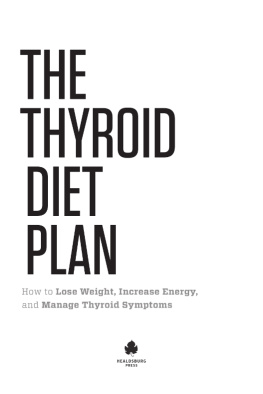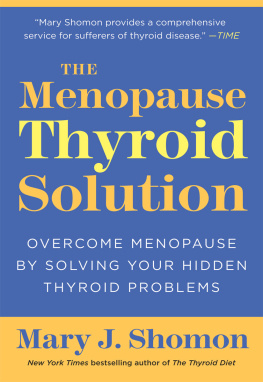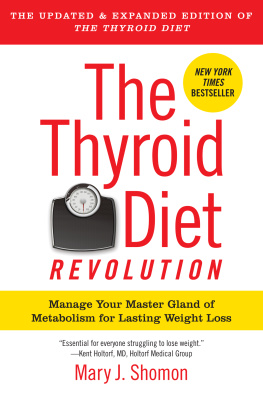This book isdedicated to all my family members and others that have to deal with thyroiddisease.
Chapter 1- An Overview of the Thyroid- What is its Function?
The butterfly shaped thyroid is thelargest pure gland of the endocrine system. It is located on the neck andusually contains the parathyroids. It plays a major role in regulatingmetabolism and as a result has a large blood supply.

The thyroid is located in front ofthe trachea, which is located in the neck. It consists of two lateral lobes inthe shape of butterfly wings. These lobes are connected by a mass of tissuecalled the isthmus. The large superior and inferior thyroid arteries supply thegland with fresh blood. A central cavity of the thyroid stores colloid. Colloidis a golden, sticky liquid composed of thyroglobulin molecules which areattached to iodine. The thyroid is the only gland in the body that collects anduses iodine.
This gland consists of empty, roundsacs called follicles into which the hormone thyroglobulin is secreted. Thewalls of these follicles are built with cuboidal (cube shaped) and squamous(very flattened) epithelial cells. Epithelial cells line the body and readilyadhere to each other. These protective cells do double duty by also producingthe raw thyroglobulin. Each follicle is surrounded by soft connective tissue.
Parafollicular cells are also foundin the thyroid. These cells are in the follicular epithelium but protrude intothe surrounding connective tissue.
The endocrine system uses hormonesto control the body. Organs of this system are spread throughout the body andinclude the pituitary, adrenal, and pineal glands in addition to the thyroidand parathyroid glands. Other organs contain some cells that secrete hormones.These cells are also a part of the endocrine system. Hormones are generallyslow acting and use chemicals to regulate cells throughout the body. While someact locally, others enter the lymph system or bloodstream and act at adistance. Most are amino acid based; the well known steroids are derived fromcholesterol. A third class is secreted from cell membranes throughout the body.
The thyroid hormone is two separatehormones that play a major role in body metabolism regulation. Thyroxine, orT4, has four iodine molecules attached while triiodothyronine, or T3, has threeiodine atoms. T4 is synthesized, or put together, in the large central cavityby combining thyroglobulin with four iodine atoms. T4 is secreted into thebloodstream. Once T4 reaches its target cell, T3 is generated and moves intothe cells interior.
The effects of the thyroid hormonecan be felt throughout the body. Because it increases the amount of glucoseoxidation, it raises body heat and ramps up the basal metabolism. A body withbalanced production of thyroxine and a sufficient amount of iodine, experiencesgood skin hydration, normal muscular function, and a healthy heart function.Too little secretion can lead to constipation due to a decline in associatedintestinal secretions or lower blood pressure. Too much of the hormone in thesystem can yield diarrhea and high blood pressure. A thyroid in balance iscritical to overall health.
Pregnancy and cold weather triggeran increase in production of thyroid hormone. The skeletal system of a formingfetus requires lots of calcium to completely develop. An increase in thyroidhormone production within the mother is triggered by pregnancy. Increases inbasal metabolism trigger heat which the body requires when chilled. Productionof the hormone is inhibited when blood pressure rises significantly. Thisnatural mechanism allows conditioned athletes to continue training withoutsuffering a stroke.
Calcitonin is a product of the Ccells, also known as the parafollicular cells. Calcium and phosphorus arecritical minerals within the body and calcitonin participates in the metabolismof these two elements by decreasing the amounts of each within the circulatingblood system. It prevents calcium absorption at the intestinal wall andinhibits re-absorption of both elements within the kidneys so that excessphosphate and calcium pass from the body in the urine.
Additionally, there are cells withinbones called osteoclasts which disassemble bone cells, thereby releasing storedcalcium back into circulation. This is normally a good thing because it allowsadaptation within the body. During pregnancy, there is a risk that the motherwill experience harmful bone loss. By inhibiting bone loss within the mother, ahealthy thyroid prevents this potentially grave depredation.
While not part of the thyroid gland,the parathyroids are usually located on the back of the thyroid. This organ isropelike with multiple tributaries. It is composed of large numbers of chiefcells with oxyphil cells scattered throughout. Chief cells produce theparathyroid hormone responsible for maintaining a functional level ofcirculating calcium within the system. It is triggered when there is not enoughcalcium in the system and opposes calcitonin effects. Calcium is important fornerve transmission, blood clotting, and muscle contraction. The function ofoxyphil cells is unknown.
Malfunctions in the thyroid manifestas either hypothyroidism, under activity within the gland, or hyperthyroidism,which is over activity. When the hypothyroidism is full-blown, it is calledmyxedema. Symptoms include feeling chilled, edema, a lowered metabolic rate,and feeling lethargic. If myxedema is caused by a lack of iodine, a colloidalgoiter is produced. A goiter occurs because follicle cells continue to producecolloid, but cannot attach the iodine to it to synthesize T4 and release itinto the body. Graves disease is the most commonly known problem associatedwith hyperthyroidism. In this disease, a malfunction within the body causes theproduction of abnormal antibodies which continually call for the production ofmore thyroid hormone. Symptoms include irregular heartbeats, sweating, highmetabolic rate, nervousness, and weight loss.
The thyroid is deceptively simple.Through the release of its hormones, it controls body function.
Chapter 2- Is Your ThyroidContributing To Your Weight Gain?
The thyroid gland is one of thelargest glands, and it is located in base of the neck. It is commonly referredto as an Adams apple. This gland is directly responsible for how much time ittakes for the body to use energy. Science has just recently released a findingthat has identified it as the cause of a number of conditions and weightissues.
















